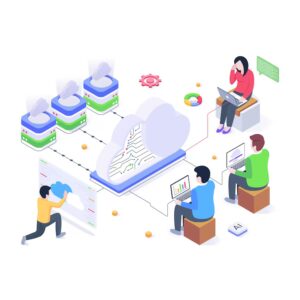Home Case Study Securing Data Management and Enhancing Compliance for a Healthcare Organization
Healthcare
Securing Data Management and Enhancing Compliance for a Healthcare Organization

Focus Areas
Data Security & Governance
Healthcare Compliance (HITRUST)
Cloud Infrastructure & Monitoring

Business Problem
A rapidly growing healthcare organization was facing escalating risks around data privacy, security breaches, and regulatory non-compliance. With patient data spread across multiple systems—including EHR, billing, and patient portals—gaps in access control, encryption, and auditability exposed the company to HIPAA violations and reputational damage. The organization needed a scalable and proactive solution to secure sensitive health data, align with industry regulations, and establish a culture of compliance across departments.
Key challenges:
Fragmented Data Management: Patient data was stored in siloed applications with inconsistent security practices.
Inadequate Access Controls: Role-based access policies were not standardized, leading to over-permissioned users.
Manual Compliance Monitoring: Audits and regulatory reporting were labor-intensive and prone to human error.
Lack of Encryption & Logging: Data in transit and at rest lacked consistent encryption, and logs were not centralized for investigation or reporting.
The Approach
Curate partnered with the healthcare organization to build a secure, compliant data environment by implementing unified governance, automating access control policies, and integrating cloud-native security solutions. The goal was to minimize risk exposure, streamline compliance workflows, and ensure trustworthy data handling across clinical and administrative functions.
Key components of the solution:
Discovery and Requirements Gathering: Curate worked with stakeholders from compliance, IT, and data teams to understand their existing security posture and compliance gaps. Prioritized needs included:
Centralize patient data storage and access
Automate role-based access provisioning and revocation
Implement end-to-end encryption for all PHI
Enable continuous monitoring and auditability for HIPAA and HITRUST
Security and Compliance Implementation:
Data Centralization: Consolidated all PHI and PII into a secure, cloud-based data lake using encrypted S3 buckets and secure VPC configurations.
Access Management: Integrated Identity and Access Management (IAM) systems with Azure AD and Okta to enforce least-privilege principles and MFA.
Encryption Protocols: Applied AES-256 encryption for data at rest and TLS 1.2+ for data in transit across all endpoints.
Audit Logging & SIEM Integration: Deployed centralized logging (AWS CloudTrail, Azure Monitor) and integrated with a SIEM solution (Splunk) for real-time alerts, anomaly detection, and forensic audits.
Compliance Automation: Used tools like OneTrust and Drata to track compliance posture, generate audit trails, and automate policy enforcement.
Process Optimization and Enablement:
Policy Frameworks: Established and documented data security policies aligned with NIST, HIPAA, and HITRUST standards.
Automated Workflows: Set up onboarding/offboarding workflows with automated provisioning and de-provisioning.
Continuous Risk Assessment: Implemented scheduled vulnerability scans, penetration tests, and security health checks.
Data Classification: Used tagging and data classification tools to flag sensitive data and apply policy-driven protections.
Stakeholder Engagement & Change Management:
Executive Buy-In: Gained leadership support by quantifying risk exposure and aligning compliance with business growth goals.
Training & Awareness: Conducted regular security awareness training for all employees, emphasizing phishing, data handling, and reporting protocols.
Governance Council: Formed a cross-functional security council to oversee controls, incidents, and improvement initiatives.
Internal Audit Support: Equipped compliance teams with automated reporting templates and dashboards to reduce audit prep time.
Business Outcomes
Reduced Regulatory Risk Exposure
Standardized security protocols and automated compliance tracking led to improved audit readiness and reduced the risk of HIPAA violations.
Improved Data Access Controls
Granular permissions and automated workflows ensured only authorized personnel could access sensitive data, reducing insider threats.
Faster Compliance Reporting
Automated logging, alerting, and reporting tools cut audit preparation time by over 60%, while improving data accuracy.
Customer Value
Stronger Security Posture
The organization proactively mitigated cyber threats and data breaches.
Operational Efficiency
Freed up compliance and IT teams to focus on innovation rather than manual audits.
Sample Skills of Resources
Security Engineers: Designed encryption, IAM, and logging architecture.
Compliance Analysts: Aligned controls with HIPAA/HITRUST standards and documented policies.
Cloud Architects: Configured secure cloud environments and data access protocols.
Automation Specialists: Developed scripts for monitoring, provisioning, and reporting workflows.
Project Managers: Coordinated implementation timelines and stakeholder communication
Tools & Technologies
Cloud Platforms: AWS (S3, CloudTrail), Azure (Monitor, Key Vault)
IAM & Access Control: Okta, Azure AD, AWS IAM
Security Monitoring: Splunk, Datadog, Snyk, Prisma Cloud
Compliance Automation: Drata, OneTrust, Vanta
Collaboration & Workflow: Jira, Notion, Microsoft Teams

Conclusion
By implementing robust data security, centralized management, and automated compliance workflows, Curate helped the healthcare organization significantly reduce risk, improve operational control, and streamline regulatory adherence. This initiative not only protected sensitive patient data but also created a secure foundation for scaling digital health initiatives with confidence and trust.
All Case Studies
View recent studies below or our entire library of work

AI Technology Roadmap & Stack Mapping for a National Healthcare Payer
Through AI consulting, Curate enabled clarity, alignment, and future-ready modernization.

Strengthening Data Governance and Security for a Technology Firm
Technology & Software Strengthening Data Governance and Security for a Technology Firm Focus Areas Data Governance Frameworks Cloud Security Architecture Identity and Access Management (IAM)

Enhancing Model Deployment Efficiency with DevOps and Automation
Technology & Software Enhancing Model Deployment Efficiency with DevOps and Automation Focus Areas Model Deployment Automation Operational Efficiency Infrastructure as Code (IaC) Business Problem A

Enhancing Kubernetes Cluster Monitoring with Custom Visualization Tools
Technology & Software Enhancing Kubernetes Cluster Monitoring with Custom Visualization Tools Focus Areas Kubernetes Monitoring Custom Dashboards Observability and Alerting Business Problem A rapidly growing